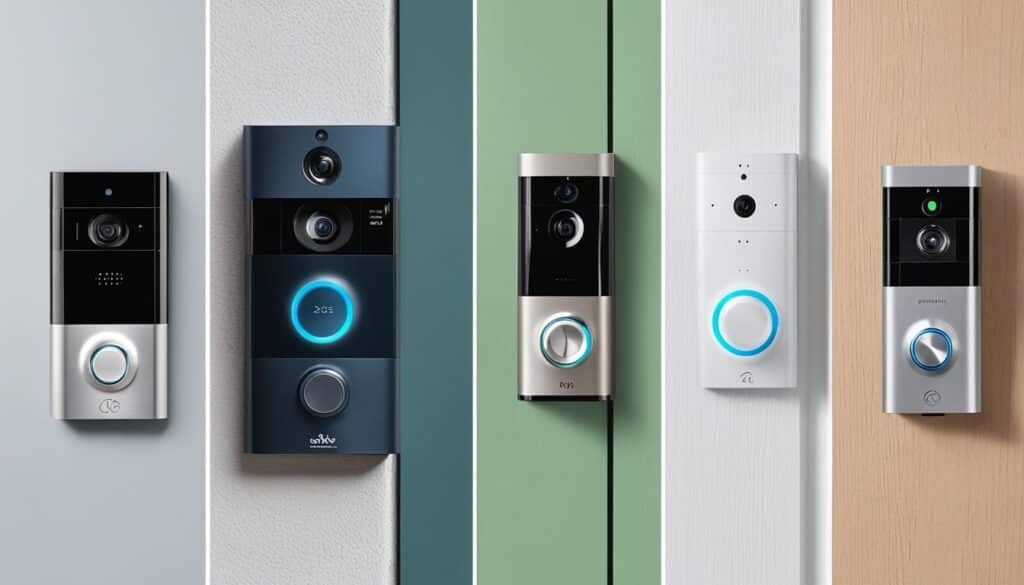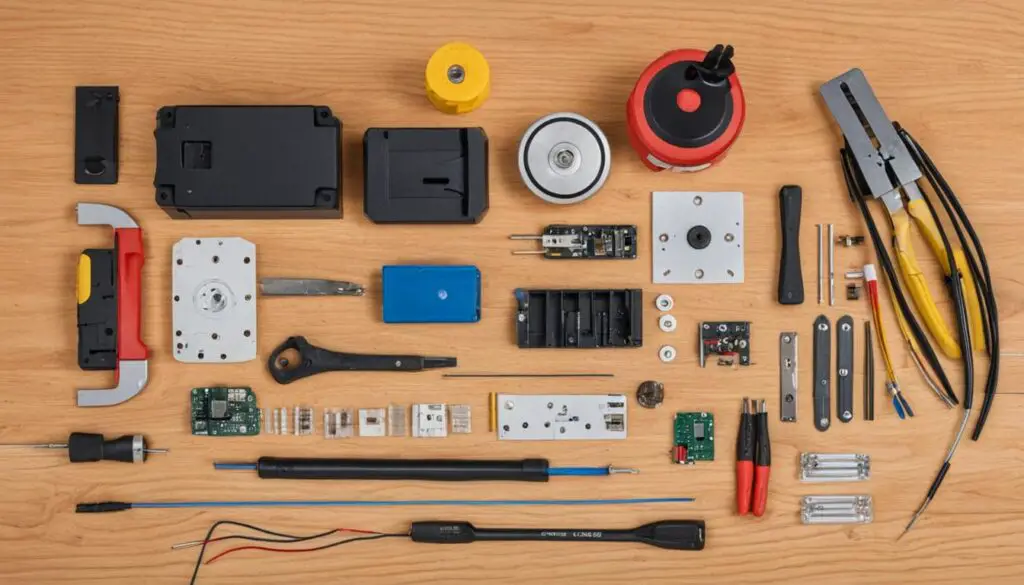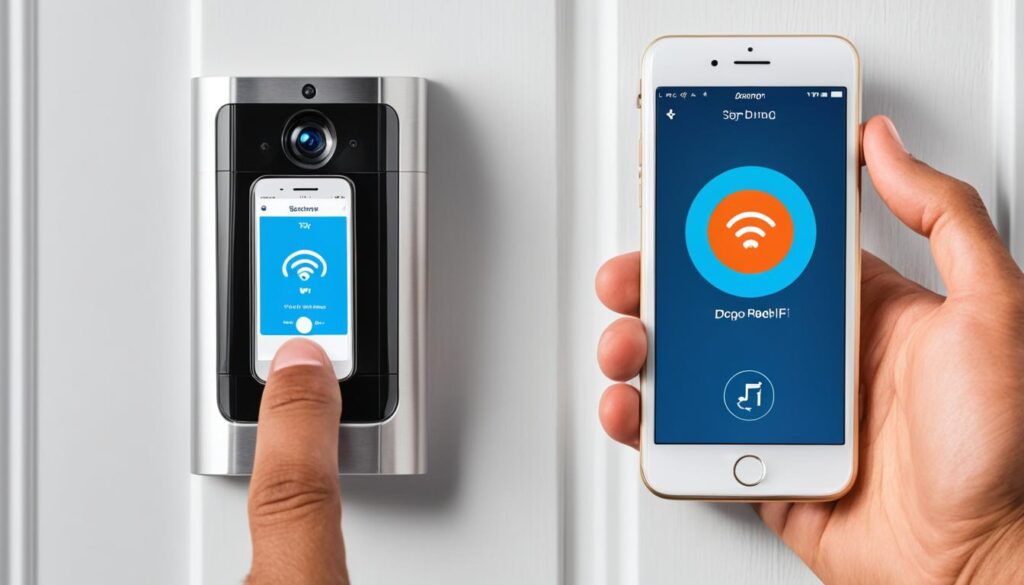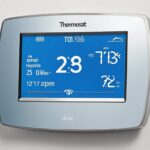Setting up a smart doorbell can greatly enhance your doorstep security. In this beginner’s guide, I will walk you through the steps to efficiently set up your first smart doorbell. Whether you’re new to home tech or just getting started with smart devices, this guide will help you navigate the setup process and get your smart doorbell up and running smoothly.
Table of Contents
Key Takeaways:
- Setting up a smart doorbell can improve your doorstep security.
- Smart doorbells offer features like video recording, motion detection, and two-way audio.
- Consider compatibility, features, and customer reviews when choosing a smart doorbell.
- Make sure you have the necessary tools and equipment before starting the installation process.
- Connect your smart doorbell to the companion app to access and manage its features.
Understanding Smart Doorbell Technology
Before diving into the setup process, it’s important to understand the technology behind smart doorbells. Smart doorbells are equipped with various features that revolutionize home security and convenience for homeowners.
One of the key features of smart doorbells is video recording. These devices are equipped with high-resolution cameras that capture live video footage of your doorstep. With this feature, you can easily monitor who is at your door, even when you’re not at home. It provides an added layer of security, allowing you to keep an eye on any suspicious activities or unexpected visitors.
Another essential feature of smart doorbells is motion detection. These devices use advanced sensors to detect motion in front of your door. When someone approaches your doorstep, the smart doorbell will alert you through your smartphone, sending real-time notifications. This feature is particularly useful for monitoring package deliveries or deterring potential burglars.
Smart doorbells also incorporate two-way audio, allowing you to communicate with visitors through your smartphone or tablet. Whether you’re upstairs, at work, or on vacation, you can interact with delivery personnel, guests, or even strangers at the door from wherever you are. This feature provides convenience and flexibility, giving you the ability to answer the door without physically being present.
Furthermore, smart doorbells offer seamless integration with smartphones. By connecting your smart doorbell to a companion app, you can access its features and settings from the palm of your hand. The app allows you to view live video footage, customize motion detection zones, adjust audio settings, and receive alerts on your mobile device. With this level of control and accessibility, you can enhance your home security effortlessly.
Overall, the integration of these advanced technologies into smart doorbells provides numerous benefits for homeowners. Not only do they offer greater convenience and peace of mind, but they also improve the security of your home by allowing you to monitor and manage your doorstep remotely.
As technology continues to evolve, smart doorbells are becoming increasingly popular for their innovative features and functionality. In the next section, we will discuss how to choose the right smart doorbell that suits your specific needs and preferences.
Choosing the Right Smart Doorbell
When selecting a smart doorbell, there are several factors to consider. First, check if the doorbell is compatible with your existing doorbell wiring or if it requires a wireless installation. Consider features like video resolution, night vision capability, and compatibility with smart home systems like Amazon Alexa or Google Assistant. Additionally, evaluate the manufacturer’s reputation, customer reviews, and warranty before making your purchase. Take the time to research and choose a smart doorbell that best fits your needs and preferences.
Investing in a smart doorbell is a decision that should align with your intentions for home security and convenience. Here are some key factors to consider when choosing the right smart doorbell:
- Compatibility: Verify if the smart doorbell is compatible with your existing doorbell wiring or if it requires a wireless installation. This will ensure a seamless setup process and avoid any compatibility issues.
- Video Resolution: Look for smart doorbells that offer high-definition video resolution, ideally 1080p or higher. This will provide you with clear and detailed footage of your doorstep.
- Night Vision Capability: Opt for a smart doorbell with night vision capability, enabling you to monitor your doorstep even in low-light or nighttime conditions.
- Smart Home Integration: Consider whether the smart doorbell is compatible with your existing smart home setup. Integration with systems like Amazon Alexa or Google Assistant can enhance the functionality and convenience of your smart doorbell.
- Manufacturer’s Reputation: Research the reputation of the manufacturer. Look for well-established brands with a track record of producing high-quality smart doorbells.
- Customer Reviews: Read customer reviews to gain insights into the experiences of other users. This can provide valuable information about the performance, reliability, and user-friendliness of the smart doorbell you are considering.
- Warranty: Evaluate the manufacturer’s warranty offerings to ensure you have proper coverage in case of any defects or malfunctions.
By considering these factors, you can make an informed decision and select a smart doorbell that meets your specific requirements. It’s worth taking the time to research and compare different smart doorbell options to find the one that best fits your needs and preferences.
Remember, your smart doorbell is an important component of your home security system, so choose wisely to ensure peace of mind and optimal functionality.

Gathering the Necessary Tools and Equipment
Before starting the setup process, it’s essential to ensure that you have all the necessary tools and equipment. Having everything prepared will make the installation of your smart doorbell a breeze. Here’s a checklist of the tools you may need:
- A screwdriver
- Wire strippers (if applicable)
- A drill (for mounting purposes)
- A smartphone or tablet to download the companion app for your smart doorbell
Refer to the manufacturer’s instructions to confirm if there are any additional tools or equipment required for your specific smart doorbell model.

“Having the right tools on hand will make the installation process much smoother.”
– [Expert’s Name], Home Security Specialist
Installing Your Smart Doorbell
The installation process of your smart doorbell will vary depending on the specific model you have chosen. However, there are general steps you can follow to ensure a successful installation. Here’s a guide to help you get started:
- Step 1: Turn off Power
- Step 2: Remove the Old Doorbell
- Step 3: Connect the New Smart Doorbell
- Step 4: Set up Wireless Connection
- Step 5: Mount the Smart Doorbell
If your smart doorbell is replacing an existing doorbell, it’s important to turn off the power before beginning the installation process. Locate your electrical panel and turn off the breaker associated with the doorbell circuit. This will ensure your safety while working with the wiring.
Once the power is off, remove the old doorbell from its mounting location. Carefully disconnect any wires attached to the old doorbell and set it aside.
If your new smart doorbell requires wiring, follow the manufacturer’s instructions to connect it to the existing wires. Ensure that the wires are securely attached and properly insulated to prevent any electrical hazards.
If your smart doorbell is wireless, you’ll need to configure the wireless connection according to the manufacturer’s instructions. This typically involves connecting the doorbell to your home’s Wi-Fi network using the companion app.
Once the wiring or wireless setup is complete, it’s time to mount the doorbell. Choose a suitable location near your front door or entryway that provides a clear view of visitors. Use the provided screws and mounting plate to securely attach the smart doorbell to the surface.
Remember, it’s essential to carefully follow the manufacturer’s instructions throughout the installation process. If you’re unsure or uncomfortable with any step, it’s always advisable to seek professional help to ensure a safe and proper installation.
Now that your smart doorbell is successfully installed, you can move on to the next step: connecting it to the companion app on your smartphone or tablet. This will allow you to access and manage the features of your smart doorbell remotely. We’ll cover this in the next section.
Connecting Your Smart Doorbell to the Companion App
Now that you have successfully installed your smart doorbell, it’s time to connect it to the companion app. By doing so, you’ll unlock the full potential of your smart doorbell and enjoy seamless smartphone integration.
To get started, follow these simple steps:
- Download the companion app provided by the manufacturer onto your smartphone or tablet. You can find the app in the Apple App Store or Google Play Store. Ensure that you are downloading the correct app specific to your smart doorbell model.
- Once the app is installed, open it and proceed to create a new account. Follow the on-screen instructions to enter your details and set up your account credentials. This account will act as the central hub for managing your smart doorbell’s settings and features.
- After creating your account, the app will prompt you to connect your smart doorbell to your home’s Wi-Fi network. This step is essential for enabling remote access and control of your smart doorbell through your smartphone.
- Refer to your smart doorbell’s user manual or the app’s instructions for the specific steps to connect your device to your Wi-Fi network. Typically, this involves selecting your network from a list and entering the network password.
- Once connected, the companion app will automatically detect your smart doorbell and display it as a linked device. From the app’s dashboard, you will have access to a range of features and settings to customize your smart doorbell experience.
- Explore the app’s interface to familiarize yourself with the available options. You can configure motion detection sensitivity, set up activity zones, adjust video quality, and enable notifications for specific events.
- Take some time to personalize your app configuration according to your preferences. You can choose to receive push notifications, enable or disable features like facial recognition or two-way audio, and customize the alert tones or chimes for incoming doorbell notifications.
By connecting your smart doorbell to the companion app, you gain the ability to control and monitor your doorbell’s functions directly from your smartphone or tablet. This convenient integration allows you to answer the door, view live video feeds, and receive alerts even when you are away from home.
With your smart doorbell and companion app successfully set up, you are now ready to maximize the security and convenience of your home. In the next section, we will explore the advanced features and settings available with your smart doorbell.
Exploring Advanced Features and Settings
Now that you have successfully set up the basic functionality of your smart doorbell, it’s time to dive into the advanced features and settings that make it truly customizable and convenient. Take advantage of these advanced options to enhance your smart doorbell experience and tailor it to suit your specific needs.
Adjusting Motion Detection Sensitivity
One of the key features of a smart doorbell is its motion detection capability. You can fine-tune the sensitivity level to ensure you receive accurate alerts and notifications when someone approaches your doorstep. Adjusting the motion detection sensitivity will help filter out false alarms caused by passing cars or animals, making the feature more reliable.
Setting Up Activity Zones
Activity zones allow you to specify certain areas within the camera’s field of view that you want to focus on. By defining these zones, you can avoid unnecessary notifications from areas that are not of interest, such as the street or your neighbor’s property. This feature is particularly useful if your doorbell camera captures a wide range of activity.
Enabling Facial Recognition
Some smart doorbells offer facial recognition technology, which allows the device to identify familiar faces and provide personalized notifications. By enabling facial recognition, you can receive specific alerts when family members or trusted individuals approach your door. This feature adds an extra layer of security and convenience to your smart doorbell.
Integrating With Other Smart Home Devices
Take your smart home setup to the next level by integrating your smart doorbell with other compatible devices. This can include smart locks, lighting systems, or even voice assistants like Amazon Alexa or Google Assistant. By creating an interconnected ecosystem, you can enhance the automation and control of your home’s security, making it more convenient and efficient.
Unlock the true potential of your smart doorbell by exploring these advanced features and settings. Customize your device to suit your lifestyle and preferences, and enjoy a seamless and personalized smart home experience.
| Advanced Features | Benefits |
|---|---|
| Motion detection sensitivity control | – Minimize false alarms – Receive accurate notifications – Focus on relevant activity |
| Activity zone configuration | – Filter out unwanted notifications – Highlight specific areas of interest – Enhance surveillance efficiency |
| Facial recognition technology | – Personalized alerts for familiar faces – Enhanced security and peace of mind – Distinguish between friends and strangers |
| Integration with other smart home devices | – Seamless automation and control – Centralized management of security – Enhanced convenience and efficiency |
Conclusion
Setting up your first smart doorbell has never been easier with the help of this beginner’s guide. By following the step-by-step instructions, you have gained the knowledge and confidence to enhance the security of your doorstep and enjoy the convenience that a smart doorbell offers.
As you continue to use your smart doorbell, remember to stay up to date with firmware updates to ensure optimal performance and security. Additionally, keep an eye on the battery level (if applicable) to avoid any unexpected interruptions in functionality.
With your smart doorbell in place, you now have the ability to effortlessly monitor and secure your home. Whether you’re receiving package deliveries or greeting visitors, you can do so with ease and peace of mind knowing that your smart doorbell has your back.
FAQ
What is a smart doorbell?
A smart doorbell is a doorbell equipped with features such as video recording, motion detection, two-way audio, and smartphone integration to enhance doorstep security and convenience.
What should I consider when choosing a smart doorbell?
When choosing a smart doorbell, consider factors like compatibility with existing wiring or wireless installation, video resolution, night vision capability, and compatibility with smart home systems like Amazon Alexa or Google Assistant.
What tools and equipment do I need for smart doorbell installation?
You may need a screwdriver, wire strippers (if applicable), a drill (for mounting purposes), and a smartphone or tablet to download the companion app for your smart doorbell.
How do I install a smart doorbell?
The installation process involves turning off power (if applicable), removing the old doorbell, connecting the new doorbell to existing wiring or setting up wireless connection, and mounting the doorbell securely on your front door or nearby surface. Follow the manufacturer’s instructions carefully and seek professional help if needed.
How do I connect my smart doorbell to the companion app?
After installing the smart doorbell, download the companion app provided by the manufacturer on your smartphone or tablet. Follow the app’s instructions to create an account, connect your doorbell to your home’s Wi-Fi network, and customize the settings according to your preferences.
What advanced features and settings can I customize on my smart doorbell?
Advanced features and settings may include adjusting motion detection sensitivity, setting up activity zones, enabling facial recognition, or integrating the smart doorbell with other smart home devices. Explore the options available through the companion app and personalize your experience.
What should I do after setting up my smart doorbell?
Regularly update your doorbell’s firmware, monitor the battery level (if applicable), and troubleshoot any issues that may arise. With your smart doorbell in place, you can now monitor and secure your home with ease.


